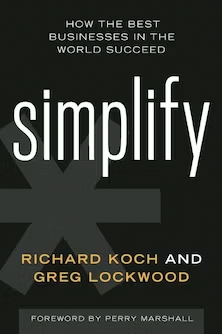How did IKEA, Apple, Uber, and Airbnb reach their level of success? They simplified! Discover the areas you can simplify in your own business with the help of this book.
By: Richard Koch , Greg Lockwood , Perry Marshall
The central premise of the book is that businesses can achieve exponential growth and success by simplifying their products, services, or processes. The authors argue that simplification can be a powerful strategy to gain a competitive edge and to create a more streamlined and efficient operation.
The book categorizes simplification into two main types:
Price Simplification: This involves reducing the cost of a product or service, thereby making it accessible to a broader audience. Companies like Walmart and IKEA have successfully employed this strategy.
Proposition Simplification: This focuses on enhancing the customer experience by offering better quality, features, or convenience. Brands like Apple and Dyson are cited as examples.
The authors provide various case studies and real-world examples to illustrate how businesses have successfully implemented these strategies. They also offer actionable insights and frameworks that can be applied to simplify various aspects of a business, from product design to customer service.
The book is often recommended for business leaders, entrepreneurs, and managers who are looking to innovate and grow their businesses. It provides both theoretical frameworks and practical advice, making it a comprehensive guide for those interested in leveraging the power of simplification.
The book does explore whether price simplification is profitable, using well-known examples like IKEA and McDonald’s. While these examples may seem self-evident, the section could be more concise, perhaps reduced to a few graphs in future editions.
The book concludes with a reality check, acknowledging that the principles of simplification don’t apply universally. Industries like Biotech, Oil & Gas, and Defense are cited as exceptions. Moreover, some sectors, such as luxury goods, thrive without necessarily adhering to simplicity.
The two core principles are most applicable to consumer-facing businesses and are particularly effective when the business model can be replicated in different locations. For instance, Uber expanded beyond San Francisco, and IKEA went global beyond its Swedish origins. Ray Kroc successfully scaled the McDonald’s model globally, although the book critiques him for not diversifying into other food categories like chicken. The implication is that the complexity of business leaders, rather than the business itself, is often the determining factor.
“Simplify” offers valuable practical insights and engaging anecdotes, although it could benefit from some editing, particularly towards the end. The book is presented with the kind of straightforward confidence that suits a public speaker but may lack the nuanced analysis that would more effectively persuade a reader.
The key takeaway is to sift through the filler content to reach the more critical insights at the book’s conclusion. From there, the onus is on you to decide if simplification is a viable strategy for your business. As the author notes, the journey may be challenging, but once you’ve settled on a strategy, it’s crucial to flesh it out in detail and execute it excellently.
Available from Entrepreneur Press


